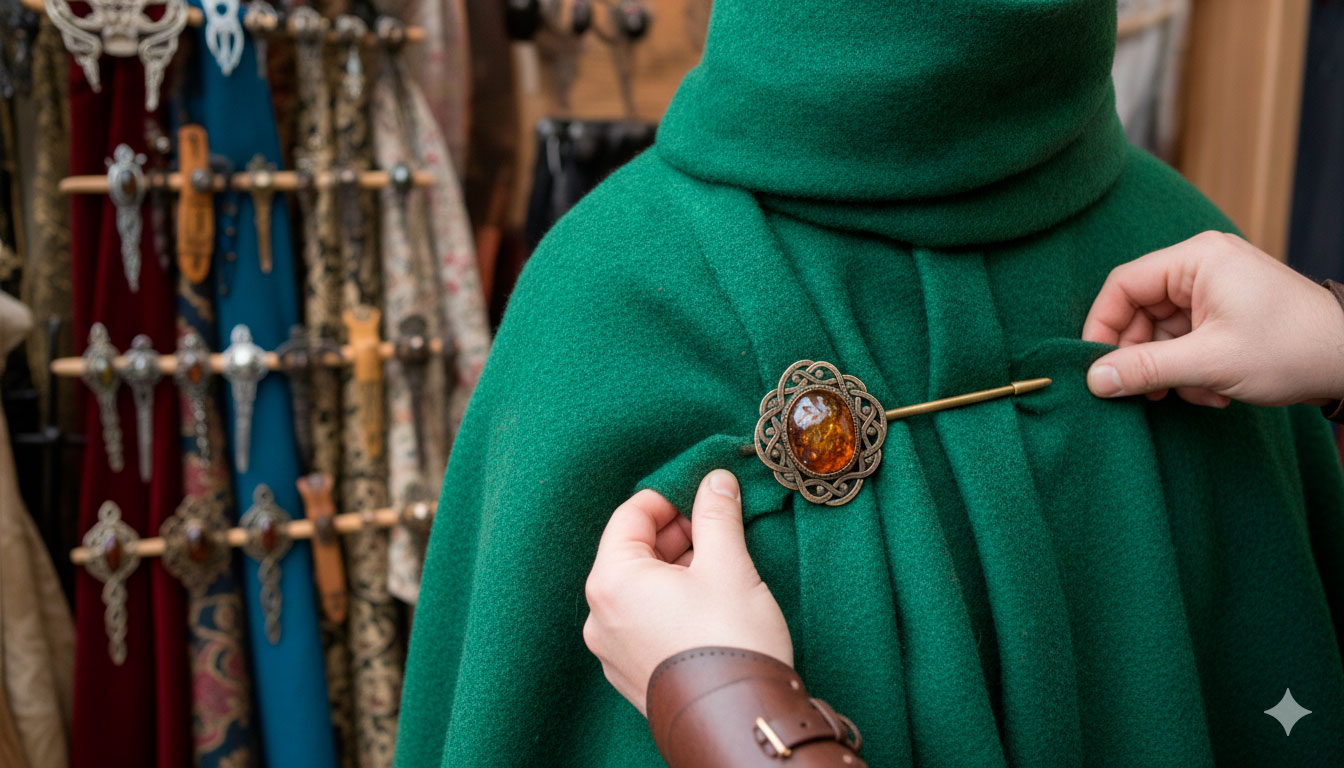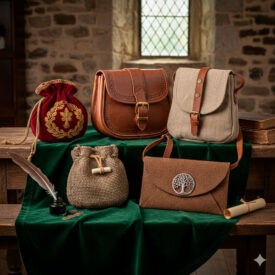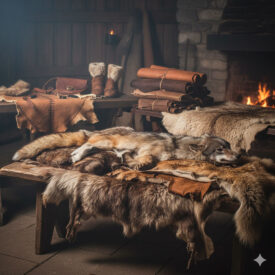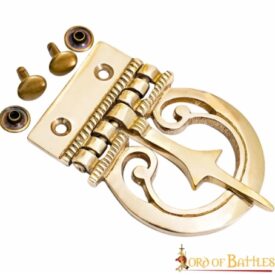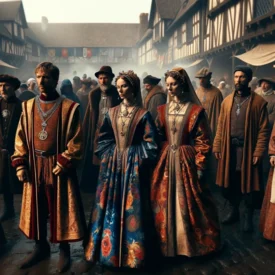In the vast tapestry of the Middle Ages, every detail of clothing told a story, and the fibula, more than a simple brooch, was an emblem of status and a key piece in the functionality of garments. Far from being a mere aesthetic whim, the correct choice of a medieval fibula for your cloak was a strategic decision that guaranteed not only elegance but also practicality in a world where every element mattered. Let’s unravel the mysteries of this fascinating accessory together!
Beyond Ornamentation: Fibula, Brooch, and Clasp in the Middle Ages
Although often confused, it is crucial to differentiate between a fibula, a brooch, and a clasp, as each served a specific purpose in medieval clothing.
A **clasp** refers to a pair of flexible strips, often adorned with teeth, that could be fastened and unfastened. Its main use was for closing garments, bags, and accessories, providing practical fastening.

A **brooch**, on the other hand, was a jewel intended primarily for aesthetic purposes, attaching to garments to enhance their beauty. While it could have some fastening capability, its value lay in its design and ornamentation.

The **fibula**, however, was the quintessential metallic pin used in antiquity to join or fasten any of the garments that made up a cloak or dress. Its relevance was magnified in an era when buttons had not yet fully developed, making it an indispensable element for everyday and ceremonial attire.
The Chronological Succession of Fibulae: A Journey Through Time
Delving into the history of fibulae is to navigate the currents of innovation and cultural evolution. From their origins in the Bronze Age to their splendor in the Middle Ages, each era left its mark on the design and functionality of these ingenious fasteners. Understanding this progression is key to appreciating the fibula that best suits your fabric and the era you wish to recreate.
The Penannular Fibula: The Master of Fastening
The **penannular fibula** stands as the most effective type for fastening cloaks and mantles, and its history is as rich as its functionality. This design, characterized by its partially open ring and a rotating pin, allowed garments to be securely fastened, distributing fabric tension and reducing the risk of tearing. Its maximum development occurred between the 6th and 9th centuries, when it reached a considerable size, and its decorated terminals ensured secure fastening. The **Celtic penannular brooch** is a clear example of this evolution, with enlarged terminals that offered a larger surface for optimal fixation.
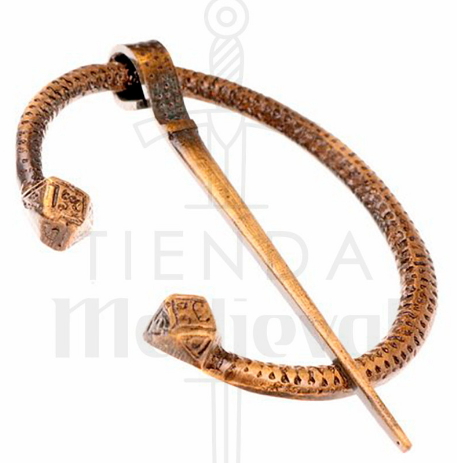
Variety of Shapes and Eras: A Universe of Fibulae
The diversity of fibulae is as vast as the imagination of ancient artisans. **Bow or omega fibulae**, very popular in Roman and Late Roman times, offered a robust spring, ideal for military and civil use. **Aquiliform fibulae**, typical of the Visigothic period, stood out for their designs imitating the figure of a bird, merging utility with regional identity.
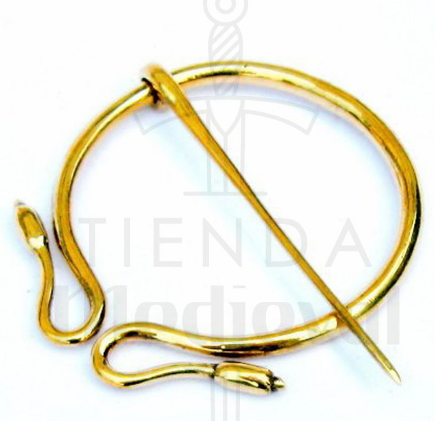
In museums worldwide, Greek, Phoenician, Celtic, Etruscan, and Roman fibulae are exhibited, each a testament to the different forms and decorations that evidence the importance given to this accessory in ancient cultures. Iberian fibulae, for example, are especially interesting for the figure of the Iberian rider that often replaced the bow, giving them a unique character. Byzantines and Visigoths also elevated this art, adorning their fibulae with pearls and glass pendants, as attested by the intricate mosaics of the era.
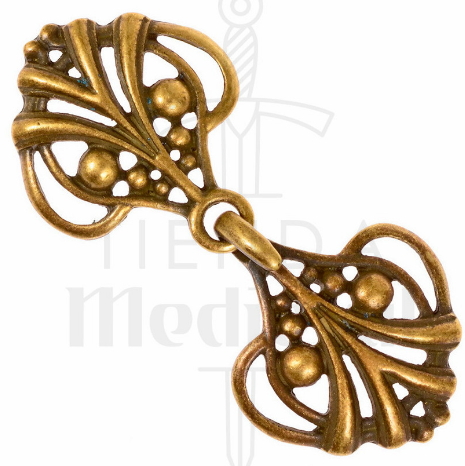
Materials for Unbreakable Fastening: The Essence of Durability
The choice of material for a medieval fibula was not a whim, but a fundamental decision to ensure its durability and the robustness of its fastening.
The Strength of Iron and the Elegance of Bronze
For functional, everyday fibulae, **iron and bronze** were the materials of choice. Iron, with its exceptional robustness, was especially recommended for frequent use, capable of withstanding the repeated stress of opening and closing. Bronze, for its part, offered a perfect combination of strength and a more refined appearance. In modern historical reenactment, **brass** presents itself as a contemporary option that balances durability and aesthetics.
Precious Metals: When Prestige Joins Fastening
**Precious metals such as gold and silver** were historically reserved for high-status fibulae, especially in ancient Rome. If you are looking for a ceremonial or display fibula, these materials project unparalleled prestige, although their malleability can make them less practical for intense daily use.
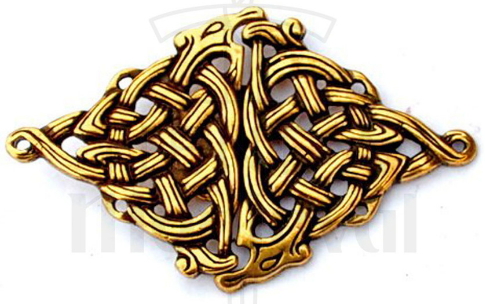
Dimensions and Scale: Size Does Matter for Your Cloak
The size of the fibula is directly linked to its fastening capacity. Large penannular fibulae, typical of the 6th to 9th centuries, were designed for ceremonial cloaks and heavy capes, achieving superior retention thanks to their larger contact surface. For moderately weighted cloaks, a fibula of approximately 9.5 x 5.8 centimeters offers an ideal balance between visibility and functionality. Smaller fibulae, though elegant, may be insufficient for thick or bulky fabrics. The length and thickness of the pin are also crucial: a robust and well-proportioned pin penetrates deeper into the layers, creating a secure anchor that prevents unwanted movement.
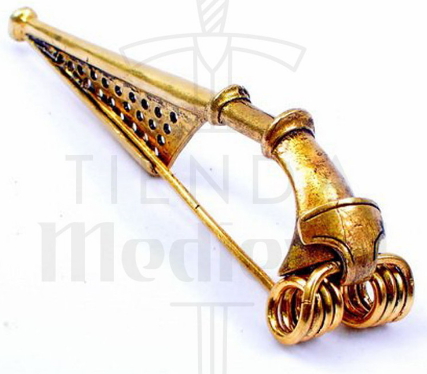
When Decoration Reinforces Structure: Techniques and Stability
Decoration in medieval fibulae was not merely an embellishment, but often affected the structural integrity of the piece. Traditional techniques such as filigree, engraving, and damascening not only added visual complexity but could also reinforce certain areas of the fibula. While enamel and cloisonné beautified the piece, incorrect application could weaken it, especially at the terminals that bear greater tension. **Chip carving** and casting were methods that optimally distributed the material for strength and functionality, ensuring that many original historical fibulae, forged in two-piece molds, had exceptional uniformity and strength.
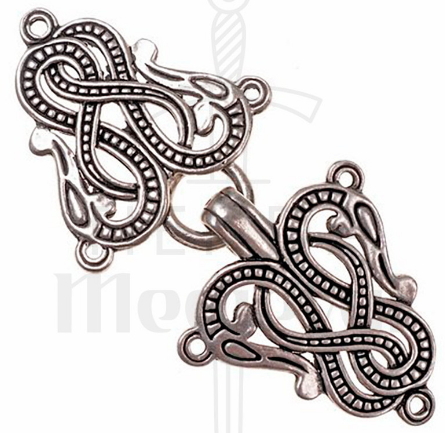
The Importance of Terminals: The Anchor of Your Cloak
The terminals of the fibula were critical elements for its performance. In the Late Roman period in Great Britain (3rd and 4th centuries), fibulae with zoomorphic decoration on the terminals already highlighted their importance. Optimal terminals should feature broad flat areas to distribute pressure evenly over the fabric, balanced decoration that does not compromise structural strength, rounded edges to prevent snagging, and well-distributed weight to prevent the fibula from tilting or slipping. Decorative motifs, such as animals, plant elements, and geometric signs, not only communicated identity or status but could also structurally reinforce the design if well executed.
Clearing doubts about fibulae: differences, materials, and techniques
What are the differences between Celtic and Roman fibulae?
Celtic and Roman fibulae present differences mainly in their design and function:
- Celtic fibulae: They tend to be larger and have a more robust style. A characteristic type is the penannular brooch, which has an open ring and a pin that rotates to secure the garment. Its design reflects a mix of functionality and art, with decorations that can be geometric or zoomorphic.
- Roman fibulae: They have a more varied shape but stand out for their functionality and refined ornamentation. They are smaller and more elaborate, with designs such as the crossbow or disc, and are usually made of precious metals such as gold, silver, or bronze. In addition to securing clothing, Roman fibulae were a symbol of social status and could include filigree, enamel, or precious stone ornaments.
What materials are commonly used to make medieval fibulae?
The most commonly used materials for making medieval fibulae are **bronze, iron, brass, and silver**.
**Bronze** was the predominant material, especially for everyday fibulae. **Silver and gold** were reserved for pieces of higher quality and value, intended for people of higher social status. **Iron** was also used, though to a lesser extent than bronze.
Regarding decorative techniques, fibulae could incorporate various elements such as glass, enamel, amber, and local precious stones in cells or cavities made in the main piece. The manufacturing process involved techniques such as **hand forging, molding, hammering, and soldering**. Many fibulae were made by **casting in molds**, which allowed the complete piece (ring, bridge, and decoration) to be created in a single pour, which was then retouched and filed to give it the final finish.
How did social status influence the design of fibulae?
Social status directly influenced the design of fibulae, as these pieces not only had a practical function to fasten garments but were also visible symbols of rank, wealth, ethnic identity, and social prestige. Fibulae of people of high social standing were usually made with noble materials such as gold and silver, decorated with precious stones, enamels, or complex motifs that reflected their power and distinction. In contrast, those of lower social classes tended to be simpler and made of less valuable materials. Furthermore, certain designs and symbols used in fibulae could indicate belonging to specific groups, activities, or religious beliefs, thus reinforcing the communication of social status through their form and ornamentation.
What goldsmithing techniques are used in the manufacture of fibulae?
The goldsmithing techniques used in the manufacture of fibulae include:
- Working wires to give them a specific shape.
- Soldering several metal pieces together.
- Melting pieces in sand molds or bivalve molds of refractory material.
- Decorative techniques such as chip carving, filigree, engraving, and the use of inlays (niello, glass, champlevé).
- Casting in a single piece (ring and bridge), followed by retouching, filing, and assembly of the spring and pin.
- In some cases, advanced techniques such as cloisonné in gold fibulae.
These techniques combine molding procedures (casting), manual work (forging, soldering), and decorative techniques to achieve both practical and aesthetic functions in fibulae. The technical variety is broad and responds to the material and stylistic complexity of the object.
What types of decoration are found on medieval fibulae?
Several types of decoration are found on medieval fibulae, including filigree, enamel, and cloisonné. Motifs such as animals, plants, religious emblems, and geometric signs are also common. Higher-status pieces usually include gemstones and elaborate decorations, while more functional ones feature simple designs.
Cloak fasteners collection for you
The Definitive Choice: Finding the Perfect Medieval Fibula for Your Cloak
The search for the ideal medieval fibula for your cloak is a journey where history, functionality, and aesthetics converge. If you are looking for an unbreakable fastening, opt for a **penannular fibula made of wrought iron** with generously sized terminals, ideally between 9 and 11 centimeters wide. Make sure the pin is robust and proportional to the size of the piece. For everyday use, functionality should prevail over ornamentation. Investing in a handcrafted piece guarantees not only reliable fastening but also longevity that will honor history and beautify your medieval attire.
VIEW MEDIEVAL CLOAK FASTENERS | VIEW MORE PERIOD BROOCHES AND FIBULAE | VIEW BEAUTIFUL MEDIEVAL CLOAKS
